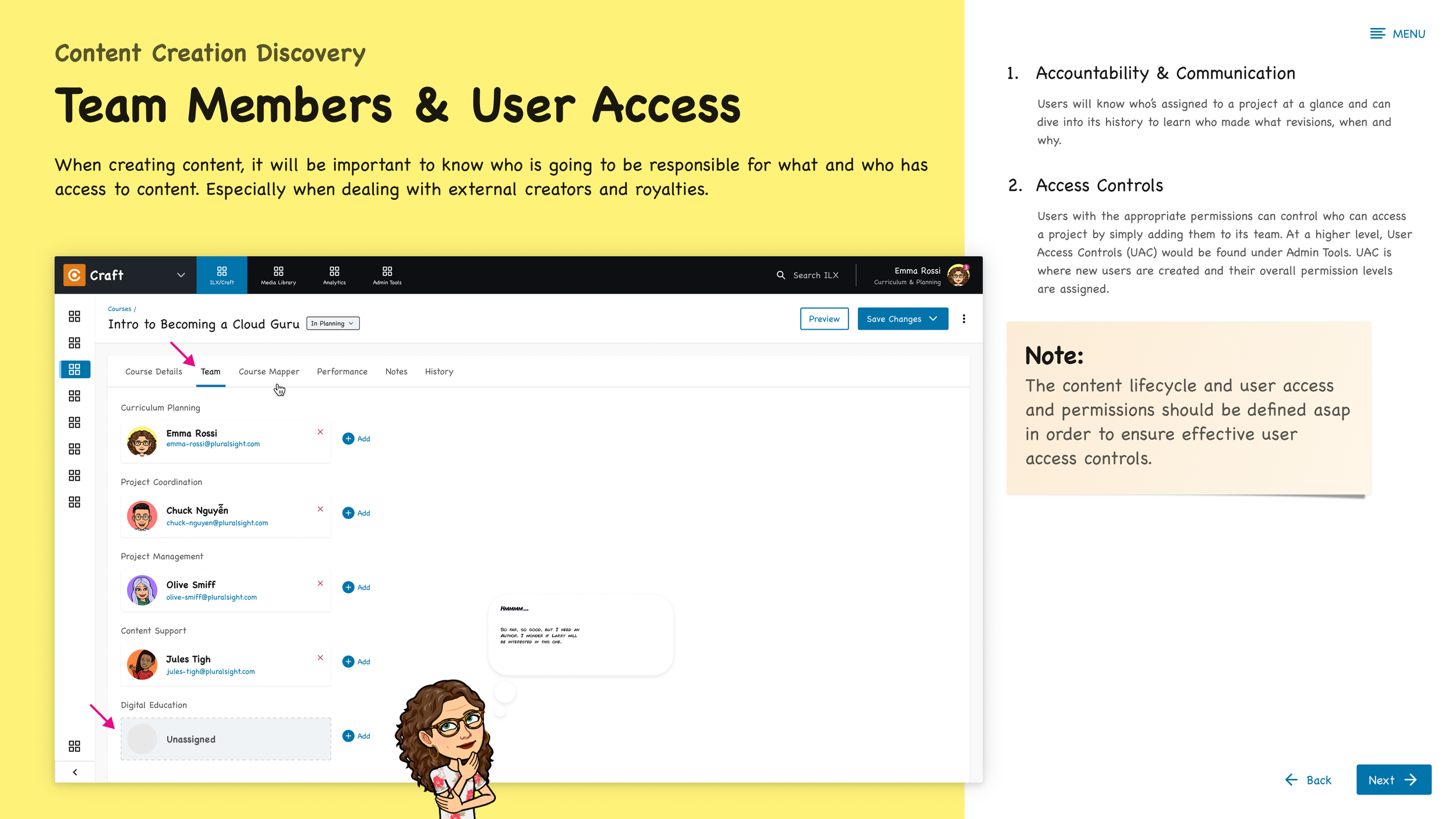United Content Platform Discovery & Future Vision
A Case Study
My Role
Discovery • UX research • Ideating • Storytelling
The Problem
Pluralsight currently has a wide variety of internal & external content creation tools throughout the organization. Each of those tools are isolated with no way to access all of them in a single area. All the tools have a unique data structure making it hard for consumers to handle all the different content types. There isn’t a scalable way to build mixed modality content.
The Solution
We think that Pluralsight and its users should bring all content creation tools together in one place. This will: 1. Improve learning results and tracking, helping learners and organizations reach their goals better. 2. Make it easier to create different learning experiences, using data and various methods, to speed up and improve the quality of Pluralsight content.
Background/acquisition
About three years ago, Pluralsight’s parent company, Vista Equity Partners, acquired the company, A Cloud Guru (ACG), an online training platform that focused on Cloud providers.
For the content producing side, that meant combining all of our tooling. On the Pluralsight side, our content producers already had separate siloed tooling for each different modality they needed to create: videos, labs, and assessments. Then we needed to combine with ACG’s tooling. Not to mention all the 3rd party tooling on top of that to contract & assign authors, track their work, communicate during the process, and connect data flow. Some of those tools included DocuSign, Salesforce, Asana, Trello, Monday.com, Dropbox, Google Docs, Smartsheet, Confluence, Zapier, and countless others.
These are all the internal tools Pluralsight and ACG has that content creators had to use to create their courses. These include all separate tooling for labs, videos, and assessments.
Where we want to go…
This brings us to the solution I mentioned above, We believe that domains, content creators, content producers, and Pluralsight in general have a need to consolidate all the content building tools into one central framework. By doing this, it will:
1. Enhance learning effectiveness and its measurement, empowering learners and organizations to more effectively achieve their goals and outcomes.
2. Facilitate data-driven, mixed-modality experience creation at scale to enhance the speed, cost, and quality of Pluralsight content production and maintenance.
We referred to this project as the Unified Content Tooling initiative. This endeavor aimed to streamline content management processes across different platforms and teams within the organization, enhancing collaboration and efficiency.
A diagram representing both Pluralsight and ACG tooling and how we intend on combining them. Diagram by Bryon Stuefer.
assembling a team
It took about 6 months after the acquisition for the leaders to prioritize the work and form a team to tackle that endeavor. At first, this team included the Senior Director of Product & Design, Lauren Gray; a Product Manager, Jeremy Kohler; and myself. We quickly learned that this project was huge and needed additional help because we were already on separate product teams doing other work. We added a couple more designers, Bryon Stuefer and Rebecca Wahl to assist us.
Our goal was to understand today’s content creation in their entirety, across both Pluralsight and ACG and how they champion the customers.
Discovery
Our initial discovery included, but was not limited to, identifying and gaining insight on:
Key content user types & their jobs-to-be done
Inventory on all the tools used throughout the lifecycle
Users’ pain-points for users
Commonalities or overlaps between lifecycles
Our intention with this research is to help create a mixed modality content building experience that will fit into our content creators’ processes, support their needs, and align with how they need to do things.
RESEARCH
Over 15 weeks, we had over 32 discovery calls, where we interviewed over 55 individuals, over 23 different departments, spanning across Pluralsight + ACG. We collected over 668 google sheet cells of observations to truly understand how our departments create content, what their processes looks like, what they struggle with, and why. For greater detail, I recommend looking at our high-level vision prototype below (at the bottom of this page).
The tabs on the google sheet represents everyone we interviewed. The rows represented the questions and grouped into categories. After the interviews were complete, I arranged the needs based on different categories.
key personas
Through our interviews, we identified 17 personas across Pluralsight & ACG. For Pluralsight, we identified 7 personas. For ACG, we identified 10 personas.
We found a lot of overlap and commonalities between the roles of both Pluralsight & ACG
We narrowed them down to 7 over-arching key personas that encompass similar roles as one another
This will help identify roles & user permissions for future features, company mergers & acquisitions... etc.
To see the personas and user flows, see our high-level vision prototype below.
HIGH-LEVEL VISION Prototype
I, along with Bryon, and Rebecca worked hard on the high-level vision prototype (shown below). This shows where we are today and where we want to go. We made a Figma prototype out of our findings and vision. This was shared out to several stakeholders as well as the VPs in our company and was received very well. It will take awhile to get there, but we believe this is the best way Pluralsight’s content creators to build courses with ease.
























































WHERE WE ARE CURRENTLY
It’s going to take awhile to get to an overarching course building tool. We have to focus our energies into building a shell of a course tool, what data from existing tooling we can bring in, what tooling can be decommissioned and when; while slowly building capabilities within the new platform that takes away the need for external tools. We estimated it’ll take about 2-3 years to get to where we want based on our high-level vision. For now, our MVP is the Course Builder tool that you can see and read about in my next project/case study.





